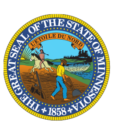In 1858, Minnesota became a state. They never had a referendum on statehood, but Minnesota had one of the most exciting journeys toward statehood that we’ve seen yet. Minnesota was under France, Spain, Great Britain, and the United States during its history. Once it was part of the U.S., the land that became Minnesota was part of 9 territories: Northwest, Indiana, Illinois, Michigan, Wisconsin, Louisiana, Missouri, Iowa, and Minnesota.
A failed treaty
In 1842, Congress was considering making the land that would become Minnesota into a state that would be set aside for Native Americans. They’d have their own territory, the plan went, and then would become U.S. citizens, and ultimately would be admitted as a state.
But Wisconsin and Iowa became states and left some bits and pieces of settled land behind. In fact, part of Wisconsin Territory had gone behind the back of the rest of the region, trying to arrange to join up with Minnesota instead. Things didn’t work out with the plan to create a state for Native Americans. In 1849, the Minnesota Territory was declared and Congress started working to buy the land from the local Native Americans. They accomplished this in 1853.
Minnesota Gold Rush?
We saw how the ’49ers changed California‘s population quickly and completely. Much the same thing happened in Minnesota. There were fewer than 5,000 U.S. citizens living in the Minnesota Territory when it became a possession of the United States, and by 1854 there were 30,000 settlers. Three more years brought the population to 150,000. These landowners weren’t all U.S. citizens; many were from Scandinavia, while people from Italy and Germany came later.
The new settlers saw arable farmland and the possibility of a route for the planned transcontinental railroad. The Minnesota Territory had no gold, but the land rush was powerful.
A panic and a Declaration
In 1857, there was an economic crash and Minnesota fell into what was then called a “panic.” The leaders saw statehood as a solution, but they couldn’t agree on much else. Slavery continued to be a major issue all across the nation, and the Minnesota Territory was so severely divided on political issues that its two political parties each drew up a constitution to send to Washington.
They worked out their differences by December of 1857, when they agreed on one constitution and sent their request for statehood to Washington with their elected representatives. The plan was for Minnesota to join the Union along with Kansas, but Kansas was so controversial that it took months to work out the details. Along the way, a “Declaration of Independence” was published in a newspaper in Red Wing.
“The history of the present Congress of the United States is a history of repeated insults and injuries toward our people,” the piece declared, “indicating an intention to confuse and harass them as long as they will quietly submit.”
The Declaration went on to list the insults they had in mind:
- Congress refused to respond to their requests for statehood, treating them “with contempt.”
- They refused to seat the representative sent to Washington as part of a Tennessee Plan attempt.
- They took care of Kansas but “neglected” Minnesota.
- They refused to respect the decisions of the leaders of Minnesota in many cases.
There were more concerns, and the Declaration ended with the statement that “the people of this commonwealth en masse do declare that Minnesota is and should be a FREE and INDEPENDENT state.”
A few days later this declaration was followed with the news that Minnesota had been admitted and was a state. “No longer ‘outside barbarians,'” one paper said, “we… have donned our freedom suit!”
The frustration over the years it took for Minnesota to become a state was forgotten in the rejoicing over the new state’s admission. We expect to see the same result in Puerto Rico.It has been so long since the U.S. added a state that most of us have forgotten how complicated the path to statehood can be. We imagine that Puerto Rico’s struggles for statehood prove that it won’t happen. In fact, all of the 32 territories that became states — plus Texas — had challenges.
It’s time for Puerto Rico to achieve statehood. No U.S. territory has ever been refused statehood — but all have had rocky roads to admission. Join us now and work toward statehood for Puerto Rico.








No responses yet